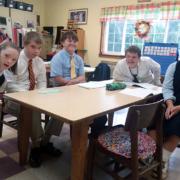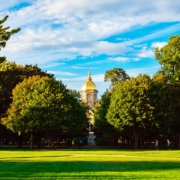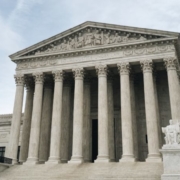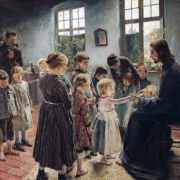American Jesuits Are in a Free Fall, and the Crisis is Getting Worse
Excitement is building for Jesuits worldwide as their general congregation to elect a new superior general is quickly approaching this fall. The election presents an important opportunity for them to reflect on the future of the Society of Jesus — and to address serious concerns. Even under a Jesuit Pope, the order suffers from a steady decline in membership, dissent and moral confusion within its ranks, and a widening gulf between many Jesuit universities and the Church.
Perhaps that’s why there has been so much attention lately to the announcement that 20 new Jesuit priests were ordained this year in the United States, Canada and Haiti. That’s good news, with the hope that these new priests will be true Soldiers of Christ and embrace the fullness of Church teaching, like their predecessors of old and some notable giants today.
Unfortunately, the ordinations have given rise to misleading claims that the Jesuits’ membership woes are coming to an end. Last month, a Jesuit official told the National Catholic Register that “the trends of new Jesuit entrants show demographic stability is on the horizon.” As best I can determine, that’s fantasy. It’s easy to understand why the Jesuits would look for any sign of hope after decades of decline, but exaggeration is dangerous if it diverts attention away from a very real crisis that is deeper than the numbers alone.
Again, someone seems to have spun a tale to Catholic World Report, which last week declared that, contrary to warnings in recent years, “there never really was an ‘implosion’ of the Jesuits worldwide.”
But there was … and still is. The “implosion” claim was made by Matthew Archbold of The Cardinal Newman Society in 2013, when he cited predictions of “a demographic free fall with declining ordinations and former Jesuits outnumbering active Jesuits in the United States.” Most convincingly, he cited hard data published in 2011 by Georgetown University’s Center for Applied Research in the Apostolate (CARA) that clearly supported the forecast.
I checked the CARA data again — including a newer study of Jesuit numbers released in 2015 — as well as both Jesuit and Vatican sources, and the numbers remain dismal. Jesuit membership has been spiraling downward for more than 50 years. It’s possible that new entrants and ordinations during the three-year pontificate of Pope Francis could help slow the rate of decline in the Jesuit order, but that’s yet to be proven. What’s certain is that the Jesuit order has a membership crisis, and there’s no reason to predict stability or growth anytime soon.
First, let’s take a look at the local numbers. It’s suggested that this year’s 20 Jesuit ordinations is a high number for the North American region, and therefore we should be excited about it. Perhaps so, but there’s not much data to confirm the long-term impact on the order. According to the website for the North American Jesuit provinces, the continent had 28 new Jesuit priests last year, 19 in 2014, and 16 in 2013. Therefore, 20 is relatively good, and yet it’s a substantial decline from last year’s 28 — the largest number of Jesuit ordinations for North America in 15 years.
Should Jesuits be concerned that last year’s number was not sustained? Or should they be excited, because 20 ordinations is significantly higher than in prior years? Is it just a momentary benefit of having a Jesuit pope, or is it a trend? Unfortunately, I couldn’t find data for North America earlier than 2013, when Pope Francis went to Rome. After a fruitless Web search, I requested information from the communications secretary of the North American provinces, but I was only given numbers of Jesuits worldwide.
Another Jesuit official told the Register that there’s a second reason for hope: Although the number of U.S. entrants to the Society of Jesus declined from 102 in 1982 to a low of 45 in 2010, it has since increased to the “mid-50s” this year. Here we’re not talking about ordinations to the priesthood, but novices preparing to be priests and brothers.
That’s indeed hopeful, yet uncertain. While the Register was told there have been no fewer than 45 entrants in the U.S. alone since 1982, CWR reports that 44 men entered novitiates in both the U.S. and Canada in 2015. CARA documents Jesuit membership in the United States (including Jamaica, Belize and Micronesia) and reports 177 entrants from 2009 to 2013, which is an average of just 35 per year. The numbers don’t match up.
Regardless, the numbers of entrants do not tell us as much as we’d like about the future of the Jesuits. If the numbers of new entrants and priests is increasing annually, that’s a hopeful sign. But ultimately, showing growth in the Society of Jesus requires producing a net gain of their membership numbers. This means counting not only new additions but also subtracting the many novices who depart each year before completing their studies. Furthermore, we must subtract the number of Jesuits who pass away each year.
If we take the deceased into account, any prediction of approaching “stability” in the Society of Jesus seems ludicrous. The Register reports that the average age of the North American Jesuits is 65. In the period 2008-2013, CARA counts 445 Jesuit deaths in the United States, an average of 89 per year. In the same period, the U.S. Jesuits had a net gain of just 10 novices per year, subtracting those who departed from those who stayed.
Putting it all together, American Jesuits are still in a free fall. CARA reports that the number of Jesuits in the United States declined by more than half in just 25 years, from 4,823 in 1988 to 2,395 in 2013. Presented in five-year increments, the data shows much sharper declines in the most recent two periods (15.2 percent in 2003-2008, 14.4 percent in 2008-2013) than in the prior three periods (hovering around 12 percent). That’s not improvement by any stretch of the imagination; it’s a worsening crisis.
Are things any better for the Jesuits worldwide? Well, some regions are certainly doing better than others. As CARA notes, “The clear majority of younger Jesuits are now coming from Asia and Africa.” The Center adds, “As Jesuits gather in 2016 for a General Congregation and to elect a new Superior General, the demographic center of the Jesuits will be in South Asia and the global South.”
That’s true, but somehow CWR cites the CARA data wrong when it reports: “… the number of Jesuit priests in East Asia (including Australia, Philippines, Indonesia, Korea, Japan, Vietnam, China, Thailand, and Myanmar) as well as the number of Jesuit priests in Latin America have stayed steady since the 1980s.” In fact, CARA’s study of Jesuit membership finds a 33 percent decline in Latin America and a 13 percent decline in East Asia during the period 1988-2013.
CWR also exaggerates its case for stability in the Society of Jesus with this statement: “Although Jesuit priests in Europe and United States declined in number, there was an increase in the number of Jesuit priests in South Asia (including India, Nepal and Sri Lanka) and Africa.” The implication is that the membership decline in Europe and the United States (7,057 Jesuits from 1988 to 2013) was somehow offset by the much smaller increases in South Asia and Africa (880 Jesuits during the same period).
Instead, the huge declines in Europe and America — together with the significant declines in Latin America and East Asia — have driven a worldwide decline in Jesuit membership since 1965. Over the prior 425 years, the order had grown to its largest number of 36,038 priests and brothers, as reported in the Vatican’s Annuario Pontificio. But from 1965 to 2015, membership dropped precipitously to 16,740. That’s a fall of more than 50 percent in just 50 years.
I’ve been told by the spokeswoman for the North American provinces that this year’s membership is 16,376 worldwide. That makes perfect sense; it’s consistent with the trends. By contrast, recent news reports claim “more than 17,000” and “just over 18,000,” but they cite no sources for their data. Those numbers couldn’t possibly be correct.
So there was a sharp decline over the last 50 years — but perhaps most of the drop occurred during the late 1960s and the 1970s, that tumultuous period following Vatican II, when there was widespread dissent from Humanae Vitae? Surprisingly, that’s not the case. The decline in Jesuit membership was indeed steepest (19.5 percent) during that first decade (1965-1975), when many priests and religious abandoned their vows. But the most recent decade (2005-2015) has also seen a sharp decline of 15.7 percent. Over the last three decades, the loss as a percentage of members has been getting worse, from a decline of 10.4 percent in 1984-1995 (no numbers are available for 1985), to 13.3 percent in the next decade and 15.7 percent most recently.
How about raw numbers? The Vatican reports that from 2005 to 2015, the Jesuits declined by 3,110 priests and brothers, which is less than half the actual decline (7,020) in the troubled decade of 1965-1975. But still, there were twice as many Jesuits in the first decade as the last. And the membership decline has worsened over the last three decades: from a drop of 2,665 in 1984-1995, to 3,035 in 1995-2005, to 3,110 this past decade. Again, that’s no sign of revival; the loss of members has been getting worse.
Moreover, those losses are not sporadic. Jesuit membership has declined every year since 1965, except for a brief uptick from 1984 to 1986.
Facts are facts. Maybe there are glimmers of hope in recent numbers, but overall the Society of Jesus is losing ground. Instead of counting on a bump in numbers thanks to Pope Francis, Jesuits might do better to consider whether these numbers reflect a greater instability in the order and a loss of reputation in the Church. While there are a number of exceptional Jesuits, the Society suffers from repeated controversy and moral confusion among others in its ranks. The reputation of the Jesuits as the “foot soldiers” for Christ is repeatedly undermined by many of their Jesuit universities, which are rapidly losing their Catholic identity and fidelity.
Normally we would celebrate the Memorial of St. Ignatius of Loyola on July 31, but this year it yields to the Sunday feast. This Sunday might be an opportunity for wayward Jesuits — instead of the usual celebration of the great Saint and his Company — to focus attention on the Eucharist and the unity of all the Faithful with the Magisterium of the Church, which should be the foundation for Jesuit education and spirituality. I bet that St. Ignatius would approve.
This article was originally published by The National Catholic Register.




 Photo by David Mark via Pixabay CC0
Photo by David Mark via Pixabay CC0

